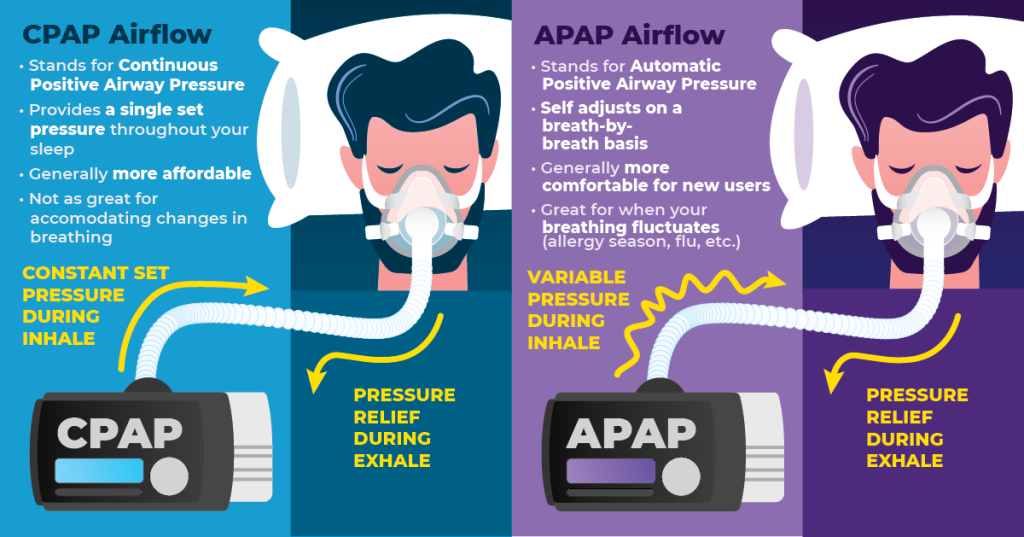If you or a loved one suffer from sleep apnea, you know how disruptive it can be to your overall well-being. Sleep apnea is a common sleep disorder characterized by interruptions in breathing during sleep, leading to poor sleep quality and various health issues. Fortunately, advancements in medical technology have given rise to APAP machines, providing an effective solution to manage sleep apnea and improve sleep patterns.
What are APAP Machines?
Auto-Adjusting Positive Airway Pressure (APAP) machines, also known as AutoCPAP machines, are medical devices designed to treat sleep apnea. Unlike traditional Continuous Positive Airway Pressure (CPAP) machines, APAP machines can automatically adjust the air pressure delivered based on the individual’s breathing patterns throughout the night. This innovative technology ensures that the patient receives the optimal air pressure needed to keep the airway open and prevent interruptions in breathing.
B. Advantages of APAP Machines Over Traditional CPAP APAP machines offer several advantages over conventional CPAP machines, making them a preferred choice for many patients with sleep apnea. The automatic pressure adjustment feature of APAP machines ensures that the patient receives the lowest effective pressure during exhalation and the highest pressure during inhalation. This dynamic pressure delivery reduces discomfort and makes it easier for patients to adapt to the therapy, improving compliance and adherence rates.
C. Effectiveness of APAP Machines in Managing Sleep Apnea Numerous clinical studies have demonstrated the effectiveness of APAP machines in managing sleep apnea. The ability of these machines to continuously monitor and adjust the air pressure according to the patient’s breathing patterns ensures that the airway remains open and reduces the occurrence of apnea events. As a result, patients experience improved sleep quality, reduced daytime fatigue, and a decreased risk of associated health complications such as cardiovascular issues and cognitive impairment.
Symptoms and Diagnosis of Sleep Apnea
Recognizing the symptoms of sleep apnea is crucial for timely diagnosis and effective treatment. Sleep apnea symptoms often manifest subtly, making it essential to be vigilant about any potential signs of the disorder.
A. Common Symptoms of Sleep Apnea
- Loud and Persistent Snoring: One of the hallmark symptoms of sleep apnea is loud and chronic snoring. The snoring is usually accompanied by choking or gasping sounds as breathing momentarily stops.
- Daytime Fatigue and Sleepiness: Sleep apnea disrupts the normal sleep cycle, leading to poor sleep quality and excessive daytime sleepiness, even after seemingly adequate hours of sleep.
- Morning Headaches: Patients with sleep apnea may frequently wake up with headaches due to fluctuating oxygen levels during sleep.
- Irritability and Mood Changes: Sleep apnea can affect mood and cognitive function, leading to irritability, difficulty concentrating, and memory problems.
B. Importance of Timely Diagnosis Detecting and diagnosing sleep apnea at the earliest stage is crucial for preventing further health complications. Left untreated, sleep apnea can lead to high blood pressure, heart disease, stroke, diabetes, and other serious health issues. If you or a loved one experience any of the aforementioned symptoms, it’s essential to seek medical evaluation promptly.
C. Sleep Study and Sleep Apnea Diagnosis To confirm a diagnosis of sleep apnea, a sleep study, also known as a polysomnography, is conducted. During the sleep study, various physiological parameters such as brain activity, eye movement, muscle activity, heart rate, respiratory effort, airflow, and oxygen levels are monitored. This comprehensive assessment helps sleep specialists determine the presence and severity of sleep apnea and guides them in devising the most appropriate treatment plan.
Explaining Sleep Apnea Treatment Options
Once a diagnosis of sleep apnea is confirmed, it’s essential to explore the available treatment options. Among the various treatment modalities, CPAP, APAP, and BiPAP machines are commonly recommended. Let’s delve deeper into these treatment options and why APAP machines are gaining popularity.
A. CPAP vs. APAP vs. BiPAP Machines
- CPAP Machines: Continuous Positive Airway Pressure (CPAP) machines deliver a constant and steady air pressure to keep the airway open during sleep. The prescribed pressure is determined during the sleep study and remains consistent throughout the night. While CPAP machines are effective in treating sleep apnea, some individuals may find it challenging to adjust to the constant pressure, leading to compliance issues.
- BiPAP Machines: Bilevel Positive Airway Pressure (BiPAP) machines differ from CPAP in that they deliver two distinct air pressure levels – a higher pressure during inhalation and a lower pressure during exhalation. BiPAP machines are often prescribed for patients who have difficulty exhaling against the pressure delivered by CPAP machines. However, BiPAP machines are usually reserved for individuals with more complex breathing problems and are not typically the first-line treatment for uncomplicated sleep apnea.
- APAP Machines: Auto-Adjusting Positive Airway Pressure (APAP) machines combine the benefits of both CPAP and BiPAP machines. As mentioned earlier, APAP machines can automatically adjust the pressure delivered based on the patient’s breathing patterns. This means that the device will deliver the lowest effective pressure needed to maintain an open airway during exhalation and increase the pressure if necessary during inhalation. This dynamic pressure adjustment enhances comfort and promotes better compliance with the therapy.
B. Advantages of APAP Machines Over Traditional CPAP
- Enhanced Comfort and Adaptability: The automatic pressure adjustment feature of APAP machines is a game-changer for individuals who struggle with CPAP therapy due to discomfort or feelings of suffocation. With APAP, the device can respond to changes in the patient’s breathing throughout the night, resulting in a more comfortable and adaptive sleep experience.
- Improved Compliance and Adherence: Compliance and adherence to sleep apnea treatment are critical for achieving positive outcomes. APAP machines have been shown to improve compliance rates due to their ability to tailor the pressure to individual needs. As patients experience better comfort, they are more likely to use the device consistently, leading to more successful long-term management of sleep apnea.
- Real-Time Data Tracking and Monitoring: Many modern APAP machines come equipped with advanced data tracking features that monitor sleep patterns, apnea events, and mask fit. This data can be valuable for both patients and healthcare providers, as it allows for better assessment of treatment efficacy and the identification of any issues that may arise during therapy.
C. Effectiveness of APAP Machines in Managing Sleep Apnea
Several clinical studies have evaluated the effectiveness of APAP machines in managing sleep apnea. These studies consistently demonstrate that APAP therapy can effectively reduce apnea-hypopnea index (AHI) scores, which indicate the frequency of apnea events during sleep. By maintaining the airway open and minimizing interruptions in breathing, APAP machines help improve oxygen saturation levels and sleep quality.
Additionally, APAP machines have been shown to effectively manage positional sleep apnea, a type of sleep apnea that occurs predominantly in specific sleep positions. As APAP devices can continuously adjust pressure based on the patient’s position and breathing patterns, they provide targeted therapy for positional sleep apnea, resulting in better overall treatment outcomes.
How APAP Machines Work
Understanding the technology behind APAP machines is essential to appreciate their effectiveness in managing sleep apnea. These devices employ sophisticated algorithms and sensors to monitor and respond to the patient’s breathing patterns throughout the night.
A. Auto-Adjusting Technology in APAP Machines
The core feature of APAP machines is their ability to automatically adjust the delivered air pressure based on real-time feedback. Advanced algorithms analyze the patient’s breathing data, including airflow, respiratory effort, and snoring sounds, to identify any irregularities or obstructions in the airway.
The APAP machine can detect events like apneas (complete cessation of airflow) and hypopneas (partial reduction in airflow), and it dynamically adjusts the air pressure to prevent or minimize these events. When an apnea or hypopnea is detected, the device increases the air pressure to restore the airway’s patency, ensuring the patient can breathe freely and comfortably.
B. Pressure Settings and Customization
Before starting APAP therapy, patients typically undergo a titration study to determine the optimal pressure range that effectively treats their sleep apnea. The titration study involves using a CPAP machine with a range of pressure settings while monitoring the patient’s sleep to find the ideal pressure level.
Once the optimal pressure range is identified, the APAP machine can be programmed to deliver pressure within that range automatically. This customization ensures that the patient receives the most effective therapy without the need for constant manual adjustments.
C. Data Tracking and Sleep Monitoring Features
Many APAP machines are equipped with built-in data tracking and sleep monitoring features. These devices record various data points during sleep, such as the number of apnea events, mask leakage, and the time spent in different sleep stages. The data is usually stored in the device or transmitted to a companion smartphone app or cloud service.
The data collected from APAP machines is valuable for both patients and healthcare providers. Patients can monitor their sleep patterns, and adherence to therapy, and identify any potential issues, while healthcare providers can use the data to fine-tune treatment settings and assess the effectiveness of the therapy.
Moreover, remote monitoring capabilities allow healthcare professionals to review patients’ progress and make necessary adjustments without requiring them to visit the clinic frequently. This not only improves patient convenience but also ensures continuous support and guidance throughout the treatment journey.
Choosing the Right APAP Machine
Selecting the most suitable APAP machine is a crucial step in managing sleep apnea effectively. Here are some key factors to consider when choosing an APAP device:
A. Factors to Consider When Selecting an APAP Machine
- Prescribed Pressure Range: Ensure that the APAP machine covers the full range of pressure prescribed during the titration study to provide optimal therapy.
- Mask Compatibility: Different APAP machines may have specific requirements for mask compatibility. Ensure that the machine is compatible with your preferred or prescribed mask type.
- Noise Level: Consider the noise level of the APAP machine, especially if you are sensitive to sound during sleep.
- Data Tracking and Connectivity: Look for devices that offer comprehensive data tracking and connectivity options to facilitate easy monitoring and communication with healthcare providers.
B. Recommended Brands and Models
While several reputable brands are offering APAP machines, some have gained more recognition for their reliability, performance, and user-friendly features. Commonly recommended brands include ResMed, Philips Respironics, and Fisher & Paykel.
Among the models offered by these brands, some popular APAP machines include:
- ResMed AirSense 10 AutoSet
- Philips Respironics DreamStation Auto CPAP
- Fisher & Paykel SleepStyle Auto CPAP
It’s important to discuss your specific needs and preferences with your healthcare provider to ensure you choose the most suitable APAP machine for your requirements.
C. Patient Reviews and Testimonials
Reading patient reviews and testimonials can provide valuable insights into the real-world experiences of individuals using specific APAP machines. Look for reviews that mention comfort, ease of use, data tracking features, and overall satisfaction with the therapy.3
NLPs and Sleep Apnea Management
As technology continues to advance, so does its impact on the healthcare industry. One of the groundbreaking innovations in sleep apnea management is the integration of Natural Language Processing (NLP) into healthcare applications.
A. Understanding the Role of Natural Language Processing in Healthcare
NLP is a branch of artificial intelligence that focuses on enabling machines to comprehend and interact with human language. In the context of sleep apnea management, NLP is utilized to analyze and interpret unstructured data, such as patient medical records, clinical notes, and research articles related to sleep medicine.
NLP algorithms can sift through vast amounts of textual data to identify valuable patterns, correlations, and insights that aid healthcare professionals in making informed decisions. For sleep apnea, NLP algorithms can assist in diagnosing the condition, evaluating treatment efficacy, and predicting patient outcomes.
B. How NLPs Can Improve Sleep Apnea Treatment
- Enhanced Diagnosis and Risk Assessment: NLP algorithms can process patient symptoms and medical histories to assist healthcare providers in accurately diagnosing sleep apnea. By analyzing the patient’s sleep study results, medical history, and lifestyle habits, NLP can help determine the likelihood of sleep apnea and its severity.
- Personalized Treatment Recommendations: NLP can help generate personalized treatment recommendations based on an individual’s unique medical history and risk factors. By considering factors such as age, weight, comorbidities, and response to therapy, NLP algorithms can assist in tailoring the treatment plan to maximize effectiveness.
- Predictive Analytics for Sleep Apnea Management: NLP can be utilized to predict potential complications or treatment challenges for specific patients. By analyzing historical data and treatment outcomes of similar patients, NLP algorithms can offer insights into potential hurdles in treatment adherence and patient progress, allowing healthcare providers to intervene proactively.
C. Future Prospects of NLPs in Sleep Medicine
The integration of NLP into sleep medicine is still in its early stages, but the growth potential is substantial. As more data becomes available and NLP algorithms continue to evolve, the application of NLP in sleep apnea management is expected to expand significantly.
In the future, NLP may facilitate more efficient sleep disorder screening and triage, enabling timely referrals to sleep specialists for further evaluation. Furthermore, advancements in voice recognition technology could enable patients to interact with their APAP machines and sleep-tracking devices using natural language commands, making the therapy more user-friendly.
Tips for Effective APAP Machine Use
To ensure the success of APAP therapy and maximize its benefits, it’s essential to follow proper guidelines for APAP machine use. Here are some practical tips to optimize your APAP therapy:
A. Proper Machine Setup and Maintenance
- Consult with a Sleep Specialist: Work closely with a sleep specialist to determine the appropriate settings and pressure range for your APAP machine based on your sleep study results.
- Mask Fit and Comfort: Choose a comfortable and well-fitting mask that creates a proper seal. Proper mask fit is crucial for effective therapy and to prevent air leaks.
- Machine Placement: Place the APAP machine on a stable surface close to your bed to avoid accidental falls and damage.
B. Overcoming Common Challenges in APAP Therapy
- Mask Discomfort: It’s normal to experience some initial discomfort when using a CPAP mask. Give yourself time to adjust, and consider trying different mask styles or sizes until you find the most comfortable option.
- Dry Mouth and Nasal Congestion: To alleviate dryness or nasal congestion, consider using a humidifier with your APAP machine. Humidified air can make therapy more comfortable and reduce irritation.
- Claustrophobia or Anxiety: If you experience claustrophobia or anxiety related to wearing a mask, practice wearing the mask during the day while engaged in relaxing activities to gradually acclimate yourself.
C. Compliance and Adherence to Treatment
- Consistent Use: Use your APAP machine every night, even during naps. Consistency is vital for achieving optimal results.
- Maintain a Sleep Routine: Establish a consistent sleep schedule to support a more regular sleep pattern and improve adherence to therapy.
- Addressing Compliance Issues: If you find it challenging to adhere to therapy consistently, discuss your concerns with your healthcare provider. They can offer support and suggest strategies to improve compliance.
By following these tips and working closely with your healthcare provider, you can optimize the benefits of APAP therapy and experience improved sleep quality and overall well-being.
Potential Side Effects and Solutions
While APAP therapy is generally well-tolerated and effective, some individuals may experience side effects during the initial stages of treatment. It’s essential to address these issues promptly to ensure successful long-term therapy.
A. Managing Discomfort and Mask Fit Issues
- Adjusting Straps and Headgear: Ensure that the mask straps and headgear are adjusted properly to achieve a comfortable and secure fit. Straps that are too tight can cause discomfort, while loose straps may result in air leaks.
- Trying Different Mask Styles: If you experience discomfort with your current mask, consider trying different mask styles or sizes to find one that suits you best. There are various mask options available, including nasal masks, nasal pillows, and full-face masks.
- Nasal Bridge Sores: If you develop sores or irritation on the nasal bridge, use a nasal pad or barrier cream to protect the skin. Additionally, adjusting the mask position may alleviate pressure on sensitive areas.
B. Dealing with Dry Mouth and Nasal Congestion
- Humidifier Use: Utilize the humidifier feature on your APAP machine to add moisture to the air you breathe. This can help reduce dryness in the nose and mouth, alleviating discomfort.
- Nasal Saline Spray: If nasal congestion persists, consider using a nasal saline spray before bedtime to keep the nasal passages moisturized.
- Oral Moisturizers: To combat dry mouth, try using an oral moisturizer or drinking water throughout the day to stay hydrated.
C. When to Seek Professional Assistance
If you encounter persistent side effects or difficulties with your APAP therapy, do not hesitate to consult your healthcare provider. They can make necessary adjustments to your treatment settings or recommend alternative solutions to improve your therapy experience.

FAQs About APAP Machines
As APAP therapy gains popularity, several common questions arise among individuals considering or currently using APAP machines. Let’s address some of the frequently asked questions to provide clarity and guidance:
A. What Makes APAP Machines Different from CPAP?
The primary difference between APAP and CPAP machines lies in their pressure delivery mechanism. While CPAP machines provide constant pressure throughout the night, APAP machines automatically adjust the pressure based on the individual’s breathing patterns. This dynamic pressure adjustment enhances comfort and effectiveness.
B. Will Insurance Cover APAP Machine Costs?
In many cases, health insurance plans cover the cost of APAP machines for the treatment of sleep apnea. However, coverage may vary depending on the specific insurance plan and its policies. It’s essential to check with your insurance provider to determine your coverage eligibility and requirements.
C. Can APAP Machines Be Used During Travel?
Yes, APAP machines are designed for travel convenience. Most modern APAP machines are compact and lightweight, making them easy to transport. Additionally, many models have universal power compatibility, allowing them to be used in different regions with appropriate power adapters.
APAP machines have revolutionized sleep apnea management, providing patients with a comfortable and effective solution to improve sleep quality and overall well-being. Their auto-adjusting technology, data tracking features, and ease of use have contributed to their popularity in the field of sleep medicine.
If you or a loved one experiences symptoms of sleep apnea, seeking timely diagnosis and appropriate treatment, including the use of APAP machines, can significantly enhance your sleep and overall health. Work closely with a sleep specialist, follow best practices for APAP therapy, and stay committed to your treatment plan for a better, healthier sleep journey.
Remember that individual experiences may vary, and addressing any concerns or challenges with your healthcare provider can optimize the benefits of APAP therapy and lead to better sleep and improved quality of life.
Frequently Asked Questions about APAP Machines
Q: What does APAP stand for?
A: APAP stands for Auto-Adjusting Positive Airway Pressure.
Q: How do APAP machines work?
A: APAP machines automatically adjust the air pressure delivered to the patient based on their breathing patterns during sleep.
Q: What is the difference between APAP and CPAP machines?
A: The main difference is in pressure delivery – APAP machines adjust pressure automatically, while CPAP machines deliver constant pressure.
Q: How are APAP machines prescribed?
A: Sleep specialists prescribe APAP machines after conducting a sleep study to determine the optimal pressure range for the patient.
Q: Can APAP machines treat other sleep disorders besides sleep apnea?
A: APAP machines are primarily used to treat sleep apnea, but they can be beneficial for certain cases of snoring and mild breathing issues during sleep.
Q: Are APAP machines noisy?
A: Modern APAP machines are designed to be quiet and minimize noise disturbance during sleep.
Q: Can I use my APAP machine during travel?
A: Yes, most APAP machines are compact and travel-friendly, making them suitable for use during travel.
Q: How often should I clean my APAP equipment?
A: It is recommended to clean the mask, tubing, and humidifier components daily to maintain hygiene and prevent bacteria growth.
Q: What is mask fit and why is it important?
A: Mask fit refers to how well the mask seals on your face. Proper mask fit ensures effective therapy and minimizes air leaks.
Q: Can I use APAP therapy if I have cold or nasal congestion?
A: Using APAP therapy during cold or nasal congestion can still be beneficial. You may consider using a heated humidifier to alleviate congestion.
Q: How long does it take to get used to using an APAP machine?
A: Adjustment periods vary, but most users adapt within a few weeks. Consistent use and mask comfort are essential for successful adaptation.
Q: Can I buy an APAP machine without a prescription?
A: In many countries, APAP machines require a prescription due to their medical classification.
Q: What should I do if I experience skin irritation from the mask?
A: Try using a mask liner or barrier cream to reduce skin irritation. Consult your healthcare provider if the issue persists.
Q: Can APAP therapy be used for children with sleep apnea?
A: APAP therapy can be used for children, but the treatment plan should be tailored by a pediatric sleep specialist.
Q: Can I adjust the pressure settings on my APAP machine?
A: While the machine automatically adjusts within a prescribed range, healthcare providers can make specific pressure adjustments if necessary.
Q: Are APAP machines covered by insurance?
A: In many cases, health insurance plans cover APAP machines for the treatment of sleep apnea. Check with your insurance provider for coverage details.
Q: How often should I replace the components of my APAP machine?
A: Masks and tubing should be replaced every 3-6 months, while filters may need monthly replacements.
Q: Can I use my APAP machine without a humidifier?
A: Yes, you can use your APAP machine without a humidifier, but using a humidifier can enhance comfort during therapy.
Q: Can APAP therapy help with snoring?
A: Yes, APAP therapy can reduce or eliminate snoring for many individuals by maintaining an open airway during sleep.
Q: Will I need to use an APAP machine for life?
A: The duration of APAP therapy varies based on individual needs and sleep apnea severity. Regular follow-ups with your healthcare provider will determine the most appropriate treatment plan.




